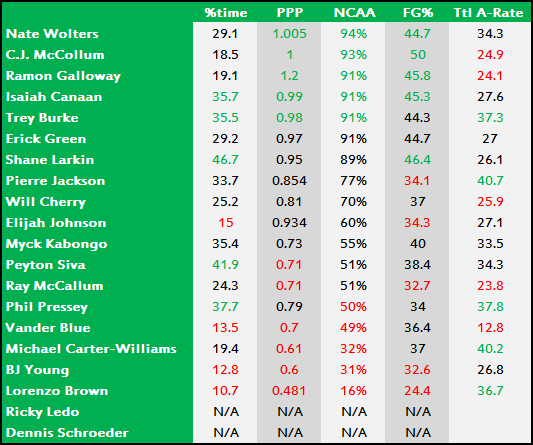Vander Blue has taken on the daunting task of transitioning to point guard at the NBA level. The decision has been criticized by many–perhaps more so than the decision to declare early itself–but only Blue and those helping him in the months leading up to draft really know if this is the right call for him to make.
All there is to do is project how Blue will play the position in the NBA. There’s not much to go on from his time at Marquette, given that the only times Blue ran the point was in three-guard sets as a sophomore with Todd Mayo and Darius Johnson-Odom alongside him.
In comparing numbers to fellow point guards in this year’s draft, consider Blue played off the ball his entire junior season and is trying to become something in two months that he’ll try to make a living off the next decade. Those around him have done so for years, and subsequently have the game tape, to show general managers and scouts.
There’s two sides to the game, and what Blue can provide on defense likely will be his calling card at the next level. What Blue must prove, however, is that he’s able to contribute as a scorer and passer. Defensive specialists (see: Wilson, Derrick) work on the collegiate level, but to earn minutes (and a contract) one must be able to score and distribute.
In this write-up his passing skills and numbers won’t come into play. What will be looked at is how Blue has performed in pick-and-roll action, perhaps the most important attribute for an NBA point guard to have. Per Synergy.com, we took ESPN.com’s top 20 point-guard prospects and measured how they performed as the ball handler in pick and rolls. The numbers only show scoring, so understand that these rankings aren’t the end all, be all. There’s another half to how point guards play within pick-and-roll sets, but we only have scoring numbers to analyze.
Those with green numbers ranked in the top five of the respective category while, you guessed it, red means he ranked in the bottom five of the top 20 point guards.
13.5 percent of Blue’s scoring attempts came off pick-and-roll action, likely with Jamil Wilson, Juan Anderson or Steve Taylor setting the screen near the free-throw line, with Blue driving toward the paint or pulling up for a jumper. Since Blue wasn’t a point guard who used the action all that much, relative to others, it’s not surprising he’s toward the bottom of this list, which ranked point-per-possession Division I percentiles. We put each player’s assist rate in on the far right for comparison-sake, but again that doesn’t mean much for Blue. He was a scorer for Marquette.
He did use the action more as a junior (13.5 percent), up from 6.3 percent as a sophomore and 4.6 percent as a freshman. So it’s fair to say he’s played more of a point-guard role last year than ever before.
Blue’s 0.7 points per possession fall in line with Peyton Siva and Ray McCallum (0.71 each) and his field-goal percentage was a respectable 36.4 percent, similar to Montana’s Will Cherry (37), Siva (38.4) and Michael Carter-Williams (37). It was notably higher than Baylor’s Pierre Jackson (34.1 percent), another scoring guard trying to make it at the point (yes, Jackson has much better passing skills, but work with it).
These numbers may not look too positive for Blue, but players such as Siva, McCallum, Phil Pressey and Myck Kabongo are other second rounders who put up similar scoring numbers to Blue in pick and rolls. Again, passing is an important part to the equation, but if Blue can improve his scoring while playing the point–remember, all Blue’s numbers came as a shooting guard–it could give him the upper hand against others ranked near him.
BONUS: Taking a more national approach, here’s a few other takeaways from the chart above.
— Trey Burke is the total package. His pick-and-roll scoring numbers ranked near the top of this list, and he was able to put up the fourth-highest assist rate. Burke is the top player on this list who played in a high-major conference, and the fact that he used pick-and-roll sets in 35.5 percent of possessions and still produced 0.98 PPP is mighty impressive. He’s far-and-away the best point guard in the class and, in this writer’s opinion, the top player in the class.
— We documented Shane Larkin’s pick-and-roll volume when Marquette played Miami, and scouts/GMs having almost 47 percent of his scoring attempts coming from such sets is important. Shooting better than 46 percent from the field on those attempts will help his stock almost as much as his Combine numbers.
— Michael Carter-Williams has upside with the best of this year’s point guards, but his lack of time in pick-and-roll sets and horrendous field-goal percentage is telling. He needs work on his shooting, and this shows why.
— Pierre Jackson shot just 34.1 percent off pick and rolls, but his points per possession gave him a top-8 ranking. What that shows is his 3-point shooting off these sets is second-to-none in the class, similar to Nate Robinson’s style of play. Teams should be looking for comparisons of the two, and this is a good starting point.
— Phil Pressey will be selected or not selected for his passing skills, but he’ll need to improve his scoring to complement it. His 34 percent shooting clip is nothing to write home about, and he’ll need to become even a small scoring threat.



Leave a comment